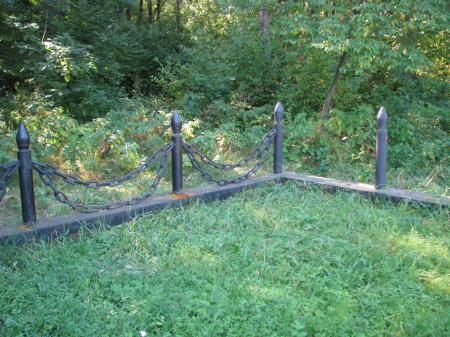Obj. ID: 14948
Jewish Funerary Art Holocaust Memorial in the forest in Sheparivtsi near Kolomyia, Ukraine, 1967

Memorial Name
No official name
Who is Commemorated?
Jewish Victims of the Holocaust from Kolomyia and nearby villages
This monument is located in a forest in Sheparivtsi Village, where mass executions of Jews took place. Concrete pavement and two black slabs with slanted tops lead to the memorial stele, a large unfinished stone with uneven surfaces and an irregular shape. The right side of the stone has a curve and leans upward to the right. The top side of the monument is unevenly beveled. To the right of this large stone, there is a smaller one. In the upper right corner of the front side of the monument there is a square black polished plaque with a Magen David carved on it. In the middle of the front side of the monument there is a rectangular black polished stone plaque with inscriptions in Ukrainian, Hebrew, and Yiddish.
Inscriptions
In Ukrainian:
Вічна памʼять
євреям м. [=міста] Коломиї
та навколишніх місць,
загиблих від рук
нацистських катів
в 1941 - 1944 р.р. [=роках]
Translation: Eternal memory / to the Jews of the c. [=city] Kolomyia / and nearby places / perished from hands / of Nazi executioners / in 1941 - 1944 y. [=years]
In Hebrew:
לזכרון נצח
של יהודי קולומיה והסביבה
שנרצחו כאן על ידי הרוצחים
הנאציים ועוזריהם בשנים
1944 - 1941
Translation: In eternal memory of Jews of Kolomyia and surroundings who were murdered here from hands of Nazi executioners and their collaborators in the years 1941 - 1944
In Yiddish:
צום אייביקן אנדענק
די יידן פון קאלאמיי און געגענט,
וועלכע זיינען דא דערמארדעט
געווארן דורך די נאצישע רוצחים
און זייערע העלפערס אין די יארן
1944 - 1941
Translation: To the eternal memory of Jews from Kolomyia and surroundings who were murdered here by Nazi executioners and their collaborators in the years 1941 - 1944.
Commissioned by
The Soviet Authority
sub-set tree:
In the summer of 1941, there were about 25,000 Jews in Kołomyja (now Kolomyia), including refugees from the west and Jews deported from Hungary. The Hungarian army occupied the city in July 1941, and the German army entered the city on August 1, 1941.
On October 12, 1941, the Gestapo and the Ukrainian Auxiliary Police took about 3,000 Jews from Kołomyja to prison, then to the forest near Szeparowce (now Sheparivtsi) and shot them there.
On October 16-17, 1918 Jews from Kosów and 114 Jews from Wierzbowiec were murdered in the Szeparowce Forest.
On November 6, 1941, about 2,000 Jews from Kołomyja were murdered there.
On November 11, 1941, a few hundred Jews were murdered there.
On December 24, 1941, 1,200 Jews with foreign passports were murdered there by the Nazis.
On January 22, 1942, 400 more Jews from Kołomyja were murdered there.
In February 1942, about 500 Jews from Obertyn were murdered there.
On February 23, 1942, 40 Jews from Kobaki Village were murdered there.
On March 29, 1942, 55-60 Jews from Rakowczyk were murdered there.
On April 8 and 11, 1942, 250 Jews from Pistyń and 900 Jews from Zabłotów were murdered there.
In September 1942, 34 Jews from Winograd and 335 Jews from Rożnów were murdered there.
About 60 percent of the 70,000 Jews who lived in Kołomyja and the nearby district, were murdered in the Szeparowce Forest. The rest were deported to the Bełżec killing center.
The monument was made by Lviv Ceramic and Sculpture Factory and was installed in the Szeparowce Forest in 1967. The Ivano-Frankivsk Regional Executive Committee included the monument to The List of Monuments of History and Monumental Art of Local Significance by decision no. 612/4 on November 28, 1969.
Since the installation, the monument has undergone several changes. Initially, the stone had an inscription (presumably in Russian) carved onto its front side. In 1997, a metal plaque, which partly covered the initial inscription, was bolted to the stone. The plaque bore an inscription in Yiddish and a black and gold image of a flame above the inscription. A black Magen David was in the top right corner of the monument.
Between 1997 and 2009, the plaque was changed. The new plaque was larger and black. It bore inscriptions in Ukrainian, Hebrew, and Yiddish. The Yiddish inscription was the same as the one on the previous plaque. A black small square plaque with a Magen David replaced the black Magen David in the top right corner of the monument. In 2009, there were cracks and holes in the plaque with inscriptions. They may have been caused by vandalism.
In 2011, the Local Jewish community renovated the monument, replacing the inscription plaque. Since then, there have been two different plaques, divided by a stone strip. One of the plaque has a mirror surface and bears a Magen David and a Ukrainian inscription. The Ukrainian text is the same as the one on the previous plaque. The second plaque, with a Yiddish inscription, seems to be the same plaque which was bolted to the monument between 1997 and 2009.
"Bez stroku davnosti," Kolomyiska raionna derzhavna administratsiia, September 29, 2011, https://kolrda.gov.ua/news/bez-stroku-davnosti (accessed May 4, 2023)
Encyclopedia of Camps and Ghettos 1933-1945, ed. Martin Dean, vol. 2 (Bloomington: The United States Holocaust Memorial Museum, 2012), pp. 790-793.
"Ivano-Frankivska oblast. Skhema planuvannia terytorii (zavershennia). Okhorona nerukhomykh obiektiv kulturnoi spadshchyny", vol. 3 (Kyiv: Derzhavne pidpryiemstvo "Ukrainskyi derzhavnyi naukovo-doslidnyi instytut proiektuvannia mist "Dipromisto" imeni Y.M. Bilokonia", 2015), p. 270., https://www.if.gov.ua/storage/app/sites/24/documentu-2022/ivano-frankivska-oblast-2015-tom-3.pdf (accessed May 3, 2023)
Photos of the monument in 2019:
"Life in Kolomyya, story 4," KehilaLink, https://kehilalinks.jewishgen.org/Kolomea/life4b.html (accessed September 7, 2023)
Solovka, Liubov and Svitlana Oryshko, 150 iz 150 tysiach... Holokost yevreiv Prykarpattia yak skladova etnodemohrafichnoi Katastrofy Skhidnoi Halychyny, (Ivano-Frankivsk: Foliant, 2019), pp. 171-174, 461.












